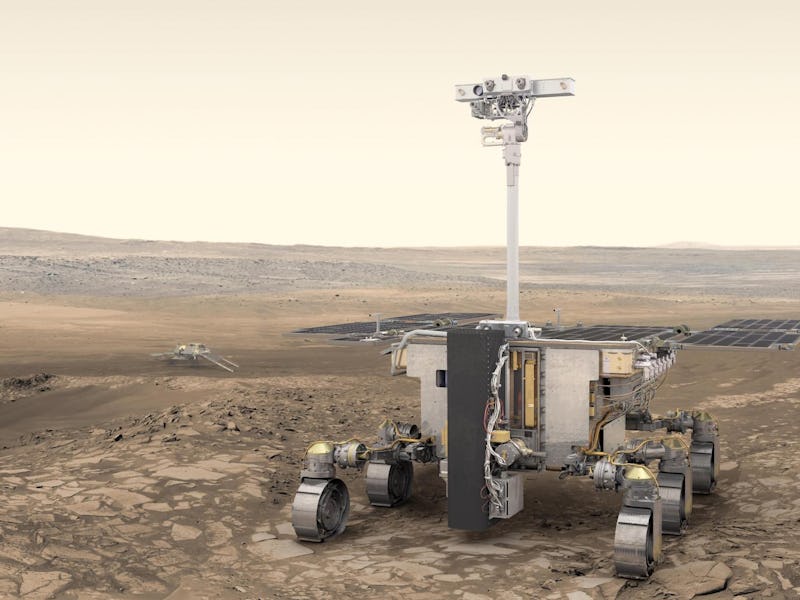Mars 2020: This is what the next generation of rovers may look like
NASA is developing a more autonomous rover to explore life on other planets.

This week marks the 20-day milestone until the launch window of July 20-August 11, 2020 opens for NASA's Perseverance rover and its journey to Mars.
While the robot explores the Red Planet, a team of scientists and engineers are already developing the next generation of alien world explorers that will be capable of making their own decisions in terms of what to analyze and what data to send back to Earth.
Scientists from the NASA Goddard Space Flight Centre announced their initial results at the Goldschmidt Geochemistry conference in June after testing out intelligent systems that will be installed on space probes set to explore Mars and worlds beyond.
The systems will debut on the upcoming ExoMars mission, scheduled for launch in 2022, before it is fully implemented on missions to more distant bodies in the Solar System.
Victoria Da Poian, an aerospace engineer at NASA Goddard and lead researcher behind the new systems, believes that artificial intelligence systems represent the future of space exploration.
"I think that all the future missions are going to be equipped with intelligent instruments, or the data received on Earth will be studied by machine learning, artificial intelligence," Da Poian tells Inverse.
Rovers like Curiosity, which is currently exploring Mars, are built with a mechanical machine learning system that lets them drive around the Red Planet.
There are two types of machine learning. The robotic, mechanical machine learning — which the Perseverance rover possesses — helps drive the rover on Mars, commanding it to stop or go, or take a picture of a sample.
However, the new generation of rovers will have more science autonomy, and will be able to answer science questions and make decisions about data independently.
As it stands today, rovers exploring other worlds beam the data they collect to a team of scientists on the ground, who then spend hours, days or weeks combing through the data and deciding what needs further analysis.
Additionally, sending back all this data hundreds of millions of miles to Earth costs a lot of time and money, which then limits the number of experiments or sample analysis that scientists can run from the mission.
Instead, the team of engineers developed a smart algorithm that will allow real-time decisions to happen on-site.
"We don’t want the scientists to waste their time and brainpower during these 24 or 48 hours studying something that is not interesting," Da Poian says. "We want to help the scientists in the decision-making process. This project will just help them be faster, and to focus on the interesting thing."
The new project takes place over three phases.
- The first phase is for the intelligent system to understand the data and translate it into a readable format.
- The second phase is to cluster the data into different groups, interesting data that require the scientists' attention, not so interesting data, and data that is similar to something that the scientists have observed before. When new raw data is received, the software tells the scientists which previous samples match this new data.
- The third phase, which is still being developed, would be a neural network capable of suggesting similar data that scientists have previously taken note of, sort of like the algorithm that suggests what else you should watch on Netflix.
The team has trained the artificial intelligence system to analyze hundreds of rock samples and thousands of experimental spectra from the Mars Organic Molecule Analyzer (MOMA), an instrument that will land on Mars onboard the ExoMars Rosalind Franklin Rover in 2023.
Artist’s impression of ESA’s ExoMars rover (foreground) and Russia’s science platform (background) on Mars.
This time around, the system will send back most of the data to Earth. In the future, the goal is for the artificial intelligence system to be given autonomy to decide which data to send back.
"We also want the algorithm to say, this is something new that I've never seen before," Da Poian says. "We don’t know sometimes what we are going to find, so we don’t want to bias the system."
NASA previously sent two other rovers to Mars, Spirit and Opportunity, which landed on the Red Planet in January, 2004. The Perseverance rover will join Curiosity rover, which landed on Mars back in August, 2012, and is still roaming the Red Planet to this day.
The goal of the Perseverance mission will be to look for clues of ancient life on Mars, and understand the history of the planet that scientists believed was once a wet, habitable world. The rover will also collect samples from Mars, stowing them away for a future return to Earth when they can be examined further.